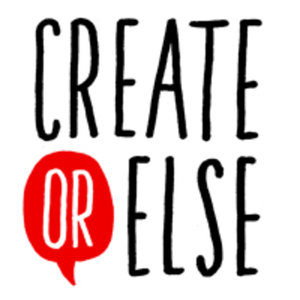 What have you created recently? Or, what have your various possessions let you create? In the comments to my post on the rise of “lets you”, it emerged that the third most common thing you can be let to do is “create.” And in fact, since “lets you know” is operating differently from the others, you could make a case that “lets you create” is the second most common thing an object can let you do, after “lets you see.”
What have you created recently? Or, what have your various possessions let you create? In the comments to my post on the rise of “lets you”, it emerged that the third most common thing you can be let to do is “create.” And in fact, since “lets you know” is operating differently from the others, you could make a case that “lets you create” is the second most common thing an object can let you do, after “lets you see.”
This is interesting, since a lot of the other common “lets yous” are very generic, or else particular to gadgetry (“do”, “get”; “choose”, “set”, “specify”). In an email, my mother writes: “Intéressant de voir la courbe de lets you create, le mot create, creator, creation étant actuellement utilisé pour toutes sortes de réalisations. Les artistes sont maintenant des créateurs. Ce serait intéressant de voir quand l’incidence de ces mots augmente.”
Indeed. In Canada it has become common to talk about artists of different kinds as créateurs, at least in French, and also in the Officialese of government granting agencies. SSHRC refers to “research-creation” as a specific granting category combining scholarly and artistic (read: “creative”) work.
If English “creative” is unremarkable in this context, and “research-creation” fairly well accepted in certain circles (SSHRC, like other federal bodies, prefers minimal pairs in translation), I think “creator” for “artist” may still sound odd to English ears, probably because of Biblical echoes (“Creator of Heaven and Earth” in French is maître–not créateur–du ciel et de la terre). Instead, “create”, “creative”, and “creativity” are what we tend to hear a lot of, often in advertising and/or corporate contexts (as opposed to official ones). My intuition, like my mum’s, is that the rise of “create” is recent.
So, to substantiate this intuition, let’s check out the Googs [click it to big it]:
 This unigram chart certainly shows an increase in the incidence of “create”, starting in the 1910s, and spiking upwards around 1980. That second spike could account for the impression of recency.
This unigram chart certainly shows an increase in the incidence of “create”, starting in the 1910s, and spiking upwards around 1980. That second spike could account for the impression of recency.
Inspecting the background data, I find that a very large number of these are in titles of the books. The following titles give the flavour of these: Understanding Those who Create (1998), Create that Change: Readymade Tools for Change Management (1997), Fabulous Floorcloths: Create Contemporary Floor Coverings (1998), Create your Own Christmas Sticker Cards (1996), Create your own Pirate Adventure Sticker Picture (1995), Cut and Create! Transportation (1997), Create Impressive Documents (1996).
All of the above titles are self-help or self-training books designed to help you make things, except the first, which is a psychological study of creativity. So the rise in the incidence may actually correspond to a rise in D-I-Y making, as well as a rise in the use of the word “create” to describe this. It may well be, unlike almost every use of Ngrams you hear about in the popular media, tracking a cultural as well as a linguistic phenomenon.
[A horrible thought: does Google Books count page headers in their ngrams, multiplying title words by the number of pages (or half the number of pages)? Anyone know? I fear the worst.]
One control we might apply is to filter out such commercial works, to see how much they’re contributing to the overall rise. Fortunately, Google lets you do see get specify make create that graph, by applying the search to their fiction corpus [ideally, they would have several different genre-filtered corpora to compare]. The blue line below is the same as above, with the red line pertaining only to fiction:
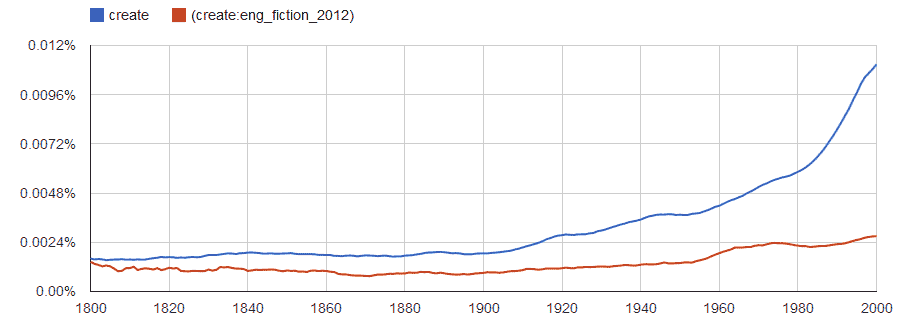 This appears to validate the idea that the rise in “create” is occurring outside of fictional works, although there does seem to me a small increase in the incidence after 1950 or so.
This appears to validate the idea that the rise in “create” is occurring outside of fictional works, although there does seem to me a small increase in the incidence after 1950 or so.
So, that’s the verb. What about the adjective, and the abstract noun that captures the concept? 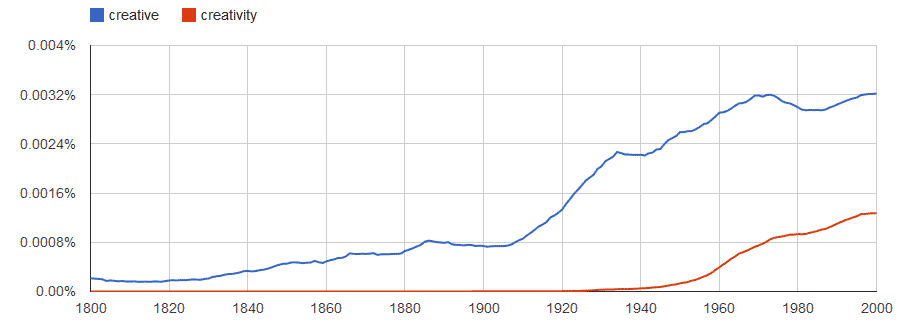 Again we’re seeing a sharp turn around 1910 for “creative”, and a sharp rise much later, in the 1950s, for “creativity.” In fact, isolating the second term emphasises how sharp and how recent the increase in “creativity” has been:
Again we’re seeing a sharp turn around 1910 for “creative”, and a sharp rise much later, in the 1950s, for “creativity.” In fact, isolating the second term emphasises how sharp and how recent the increase in “creativity” has been:
 But when we put all three words on the same axis, it’s clear that whatever rise in incidence experienced by the “creative” and “creativity”, the verb “create” is the term really dominating the Google Books corpus:
But when we put all three words on the same axis, it’s clear that whatever rise in incidence experienced by the “creative” and “creativity”, the verb “create” is the term really dominating the Google Books corpus:
A final few charts to round out the story. What about mum’s email? What does the picture look like in French? Here are some corresponding graphs from the Google Books French corpus. I’ll let you draw your own conclusions.
And here’s a challenge: what analogous terms would you use to compare the incidence in the French corpus to the incidence in the English one? Tricky. créativité/creativity is likely the best pair, but I have a feeling there’s a bit of anglicisme going on there, which seems to be borne out by the graph:
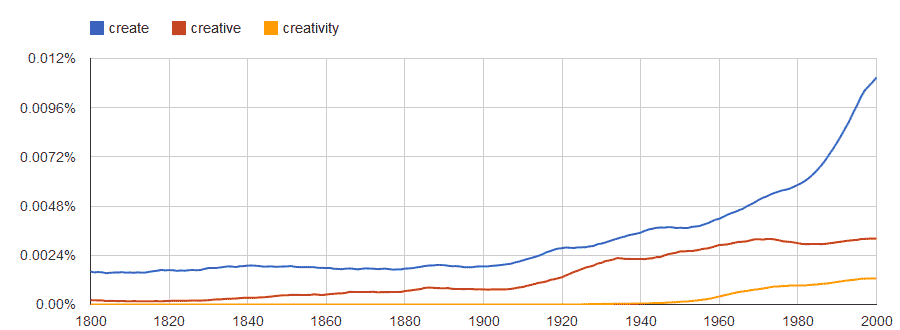
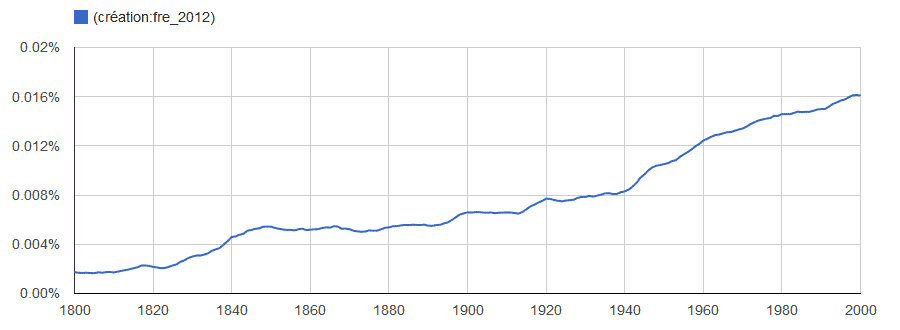
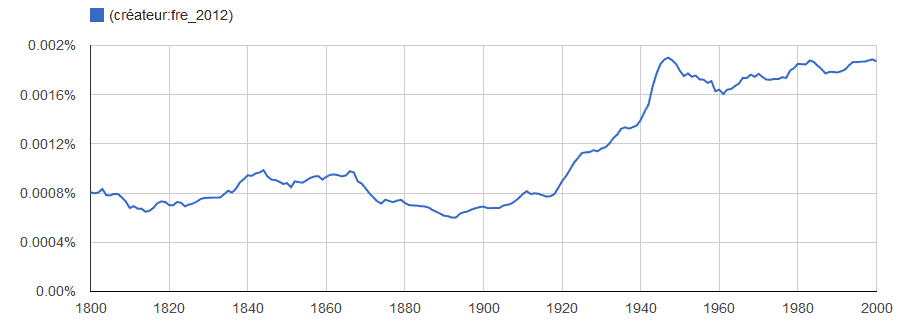
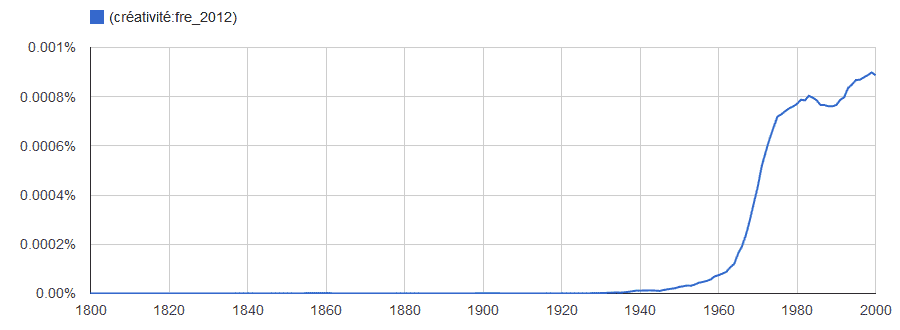
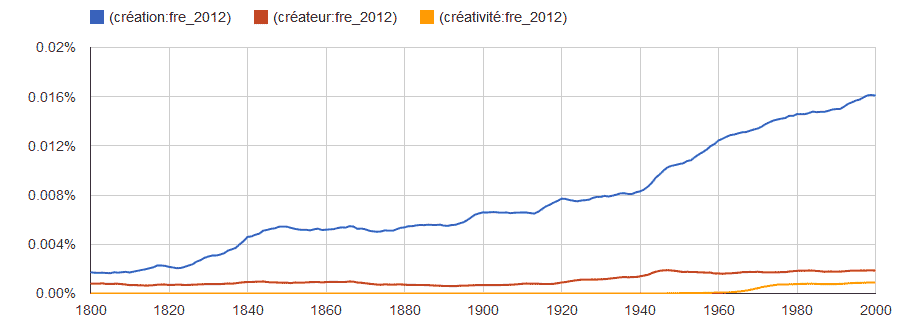
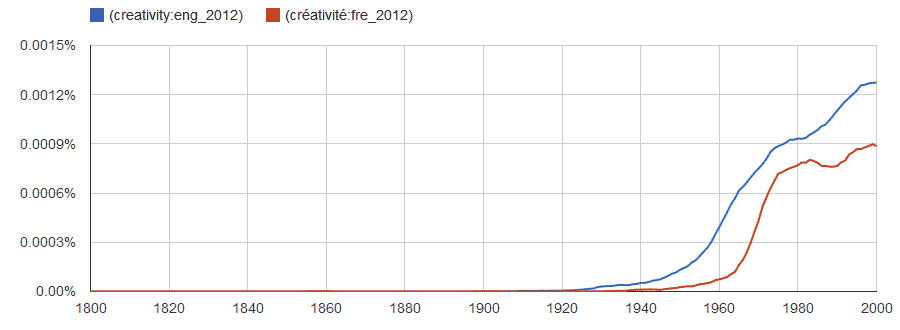
I find your point regarding ‘Biblical echoes’ (“Creator of Heaven and Earth” in French is maître–not créateur–du ciel et de la terre) extremely interesting. This would also explain the reason why in Italian, a sister language of French, ‘Creatore’ did not seem to take off as much as in French. Indeed we do refer to God as “Creatore del Cielo e della Terra”…
Interesting about “creatore”. What about “creazioni” for made objects, as in “creazioni artigianali”? Is it as twee as English “creations”? Or unremarkable?
It is true that “creazioni” is now largely used, but it still sounds quite sophisticated I would say.